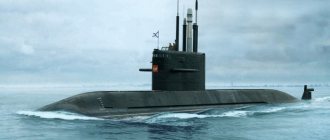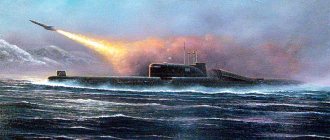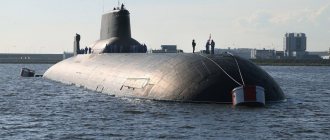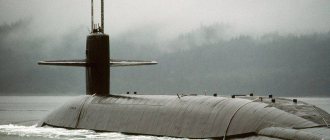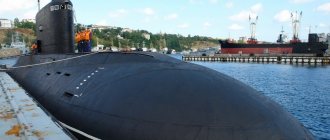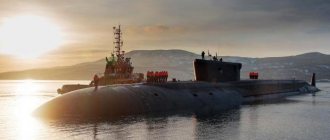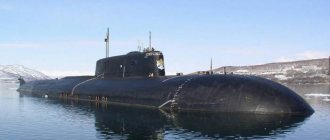Submarines with a single diesel engine . At the beginning of the 20th century, general ideas about the structure of the power plant of submarines were formed, which to one degree or another are still alive.
We are talking about the use of separate engines for surface and underwater navigation.
In the first mode, a diesel engine is used, in the second - during underwater movement - electric motors powered by batteries (the use of the indicated types of engines is not provided for only on nuclear submarines).
The main disadvantage of this approach to the design of submarines is the extremely limited time the boats can stay under water due to the insignificant life of the batteries.
Since the 1930s Both the USSR and Germany initiated intensive development of new types of engines for submarines with one single goal - to increase the duration of submarine voyages under water.
The new engines were supposed to move boats with equal efficiency both above and under water.
As a result, German engineers developed a special device “snorkel” (from German Schnorkel - breathing tube), and Soviet scientists developed its analogue - RDP (interpretation: engine operation under a periscope).
Every single German submarine produced before the mid-1940s was equipped with snorkels, and every Soviet diesel submarine produced up to the 1960s was equipped with RDP devices.
Both devices were a shaft rising above the water.
There were two channels inside the shaft: through the first, air was taken in that was supplied to the diesel engine, and through the second, exhaust gases escaped.
Due to the imperfect design of the first RDPs, exhaust gases often penetrated into the working compartments of the boat.
Later, serious design changes were made to the RDP, which freed the submarines from this drawback.
This device ensures that the batteries are charged from the running diesel engine of the submarine when it is under the periscope, and the submarine moves at low speed (up to 5 knots) at a periscope diving depth of about 10 meters.
But this mode of submarine navigation can be considered “technological”, since it cannot be used for torpedo attack.
And the mode of such navigation itself, especially in stormy conditions, requires highly qualified personnel (primarily a helmsman on horizontal rudders).
When the sea state is 4-5, it is very difficult to keep the boat at a depth that ensures normal operation of the RDP.
With each “incursion” of a wave, the boat “fails”; to prevent water from entering the diesel compartment, the float valve closes the shaft, and the access of atmospheric air to the diesel engines is stopped.
The engines begin to draw air from the compartments, which leads to the creation of reduced pressure in them.
In humans, this affects the ears and even bleeding from the ears and nose. It is especially difficult for the personnel in the diesel compartment.
When the wave leaves, the boat “floats up”, the pressure in its compartments normalizes. And so on with every wave.
Photo 1. This is what the S-80 Project 644 missile submarine, which perished on January 27, 1961 due to RDP failure, looked like after being raised in 1969.
Sometimes we even had to float up so that the shaft with the float valve was above the level of the rough sea, which, of course, unmasked the boat.
Emergency situations while sailing under the RDP could even end in tragedy.
Thus, on January 27, 1961, the S-80 missile and torpedo boat of the Northern Fleet was returning to base from a combat training site in a severe storm.
During high seas, the conning tower fence of submarines of this project is flooded with water, and in this case, water gets inside the boat through the open conning tower hatch.
For this reason, the boat was moving under the RDP, which was determined later, after the boat was raised.
A long search for the boat did not yield any results, and only in the summer of 1967 it was discovered at a depth of about 200 meters, when fishing vessels in this area of the sea recorded repeated cases of fishing nets breaking.
Two years after that, the boat was raised.
It was established that the cause of death of the boat and sixty-eight sailors was poor-quality assembly of the RDP float valve during its modernization.
The wave knocked out the rubber sealing ring on the valve air damper plate.
Through the resulting gap, sea water began to flow into the air duct of the RDP with increasing pressure as the boat sank, and then, through the open lower backup valve for supplying air to the diesel engine, into the fifth compartment of the boat.
This valve has a manual drive, and to close it, you need to turn the valve flywheel with a diameter of 500 mm several tens of revolutions.
The increasing water pressure on the valve plate with a diameter of about 450 mm did not allow the mechanics of the diesel compartment to close the valve even with the help of a lever (a steel pipe with a diameter of 50 mm was bent).
The mechanics of the 5th compartment, being at an open valve, were the first to die. The submariners of the 3rd and 4th compartments did not survive them much.
An avalanche of water, destroying the bulkheads, flooded three compartments, and the boat collapsed stern down onto the ground.
The survivors in other compartments understood the hopelessness of their situation: the depth of -200 meters for the boat was prohibitive, the released emergency buoys did not reach the surface - the length of the cable cables was only 125 meters, but there was no panic.
The table set in the wardroom testified to this. The bodies of the dead submariners removed from the boat were recognizable - this was due to the constant water temperature of +4 °C.
The sailors were buried with honors.
It was decided not to restore the submarine.
The massive use of the RDP system on submarines did not stop work on the creation of the so-called single engine.
The movement of the boat in a submerged position in this case is ensured by the operation of diesel engines according to the “anaerobic” principle (closed cycle), that is, without intake of atmospheric air.
It was planned to use the same engines when moving the boat on the surface, but using atmospheric air.
Such a power system is called a single-engine power plant .
Regenerative engine
One of the first attempts to create a single engine was made in 1935 by an employee of the Leningrad TsKB-18 (now the Rubin TsKB in St. Petersburg) engineer S.A. Bazilevsky (later Doctor of Technical Sciences) with the assistance of Professor I.D. Mendeleev, the son of the famous scientist.
When the engine was operating in the submerged position of the submarine, part of the exhaust gases, after enriching them with oxygen, returned to the diesel suction manifold.
The rest of the exhaust gas was pumped into special cylinders using a compressor, which could be periodically emptied overboard.
The oxygen supply was stored on board the submarine in a liquid state. This ensured the compactness of the oxidizer supply.
Photo 2. Diesel-electric missile submarines of Project 644 for underwater travel were equipped with an RDP device
Bazilevsky named the engine for such a power plant REDO - regenerative single engine for special purposes .
Tests on a submarine, which began before the Patriotic War, were not completed, were stopped with the outbreak of the war, and were not resumed after it.
In 1936, bench tests of a power plant using a diesel engine operating in a closed cycle were carried out.
It was called IVR (diesel operation on artificial air with the dissolution of carbon dioxide in sea water).
The principle of operation of the installation was as follows: the entire flow of exhaust gases after the refrigerator-muffler and separator entered the adsorption column, where sea water was supplied through spray nozzles.
Intensive gas washing occurred and, as a result, carbon dioxide was dissolved.
The resulting solution was pumped overboard. The undissolved part, mainly nitrogen, was separated and sent to a mixer, where oxygen gas was supplied through a metering valve.
Photo 3. Submarines M-401 (S-135) built before the war with a single engine with a chemical absorber (ED-KhPI) and S-92, equipped with REDO
In April 1940, on an 800 hp diesel engine. With. When working on this cycle, we obtained a stable power of 500 hp. With.
Further tests were interrupted by the war, and after its end, work was not resumed, since preference was given to promising power plant designs.
After the war, developments were dominated by two schemes of power plants with a single diesel engine operating in a closed gas-oxygen cycle: the ED-VVD scheme (a single engine with exhaust into water, diesel) and the ED-KhPI scheme (a single engine with a lime chemical absorber).
Appearance and structure of the submarine "Varshavyanka"
The ideally streamlined shape of this diesel-electric submarine “Varshavyanka” was designed based on the results of numerous tests. Experiments with the shape lasted until the appearance of a submarine of the same type in the United States, called Alkabor, whose cetacean hull was repeated in the Soviet submarine.
This shape allows you to reduce hydraulic resistance and swim faster. In addition, this type of housing further reduces noise, because friction is minimal. In addition to all this, this submarine minimally reflects echolocation signals due to a special coating.
As you know, the design of the boat is two-part, based on a light and durable hull. The space between them is filled with main ballast tanks. On the hull itself there is a massive lightweight cabin to protect retractable devices and antennas. It is located directly above the second compartment of the boat.
The Varshavyanka-class submarine has folding horizontal control rudders at the front.
On the bow of the boat, which is divided into two decks, there are torpedo tube shafts on top and a sonar antenna on the bottom, which is used to detect targets. Moving towards the stern, you can count six compartments.
After the bow there are the first three compartments on three decks.
The first contains torpedo tubes on the upper deck, the middle one houses part of the crew, because one of the living decks is there. At the very bottom are the batteries.
The second compartment can be regarded as a command post; on its three levels there is a central post, a navigation room and a radio room, respectively.
The third compartment, with two living decks and a battery room, is the last three-deck compartment.
The diesel submarine of the Varshavyanka project is equipped with two types of engines located in the last three compartments. So, in the fourth compartment there is a diesel engine. An electrical unit is installed in the adjacent compartment, and at the very end there are power plants of the same type, but less powerful. Their main task is to ensure economical running.
On your own oxygen
In the ED-VVD scheme, as in REDO, the main part of the exhaust gases, having passed through the gas cooler and separator, entered the gas mixer, where oxygen was added to it, and then this mixture burned in the diesel cylinders.
The rest of the exhaust gases were taken by the compressor and thrown overboard through special spray devices into the propeller jet.
In the post-war period, according to the documentation of SKB-143 (now the Marine Engineering Bureau "Malachite" in St. Petersburg), the boat, on which a power plant was installed before the war according to the REDO scheme, was converted to the ED-VVD scheme.
During 1950-1953, this submarine underwent state tests.
At the same time, a submarine with an ED-KhPI type power plant also underwent such tests.
The test results showed that the ED-VVD cycle had no advantages compared to ED-CPI.
In addition, a boat with an ED-VVD in a submerged position left a noticeable gas bubble trail, which was how it was unmasked.
Photo 4. Submarine M-401 (S-135) with ED-KhPI engine during testing
These circumstances led to the cessation of work on this topic (as subsequent experience showed, concerns about the unmasking effect of the gas bubble trail were exaggerated).
For submarines with a power plant according to the ED-KhPI scheme, fate was more favorable: they were accepted into the USSR Navy.
The development of the project of this submarine was carried out in 1938-1939 in a special NKVD design bureau, the so-called “sharashka”, by “convict engineers”.
The design bureau was located on the territory of Leningrad (now the territory of the state enterprise "Admiralty Shipyards", the city of St. Petersburg).
Tests of the submarine were carried out during the war in the Caspian Sea for several years, often interrupted due to accidents and equipment failures, and were completed at the end of 1945.
The creators of the new installation were faced with “surprises” at every step. They began with the loading of liquid oxygen.
Having no experience in this matter, the sailors began receiving liquid oxygen in the same way as they usually received fuel or fresh water: through a hose from a tank truck through a funnel.
The oxygen first evaporated and began to enter the boat container in the form of steam, then, after the hose cooled, films of liquid oxygen began to appear in the form of small pancakes.
One such “pancake” splashed out of the funnel onto the deck with an explosion. Oxygen intake was stopped.
As a result, a crack about a meter long appeared in the light hull of the submarine, and in the durable hull, in the area where the tank ventilation pipe exited, a crack also appeared as a result of the continuous bleeding of oxygen gas.
It turns out that the submarine had to be filled with liquid oxygen through a hose connected tightly to the tank.
Photo 5. Mortgage board for the M-352 submarine of the A615 project
There were great difficulties in adjusting the supply of oxygen gas when fuel consumption changed.
Neither automatic regulation of oxygen supply nor gas analyzers that constantly record the oxygen content in the gas mixture existed then.
Depending on the change in pressure in the gas-tight sealed compartments, the color of the gas environment changed.
The light brown color of the gas environment and the decrease in pressure in the compartment indicated an insufficient supply of oxygen.
If the pressure in the diesel compartments increased, indicating an excessive supply of oxygen, the color of the gas environment became pale blue.
The operator observed this change through special windows and opened or closed the oxygen supply valve.
Ensuring the gas tightness of the diesel engine turned out to be an intractable problem. Exhaust gas penetrated into the diesel compartment through leaks, fumes from fuel and oil leaks were added to it, and the risk of fire increased.
During the operation of the diesel engine and after it was stopped, people were prohibited from staying in the engine compartments without isolating devices.
Ventilation of the compartments was carried out by transferring diesel engines to the surface cycle.
During the tests, there were several cases of explosions (pops) that led to fires in the diesel compartments.
Detailed studies and explanations of these phenomena were not carried out; the maintenance personnel were usually blamed for poor maintenance of the power plant.
In 1942, during factory sea trials of a submarine with ED-KhPI, a serious accident occurred.
When the submarine was in a submerged position while the diesel engines were operating in a closed cycle, the operator at the control panel discovered that the valve in the oxygen supply network was jammed in the open position, the pressure in the diesel compartment began to increase rapidly, and the color of the gas mixture became bluish.
The submarine commander decided to surface.
At this time, the author of the project V.S. Dmitrievsky saw a fire in the diesel compartment through the window and, without the commander’s permission, opened the door and entered the emergency compartment.
A few seconds later he jumped out of there with his clothes on fire - the fire in the diesel compartment continued.
Dmitrievsky, fearing an increase in pressure in the oxygen tank, arbitrarily opened the valve for bleeding oxygen into the central post, and a fire started there too.
Photo 6. The lead submarine of Project 615 - M-254 on the Neva River - after modernization and dismantling of the gun mount
After the boat surfaced, the valve to the central post was closed and the valve for bleeding oxygen overboard was opened, but the fire continued.
The commander ordered the personnel to leave the boat and move to the surface ship providing testing.
Many sailors received burns, and the burned V.S. Dmitrievsky could not be saved.
In 1946, work on the project was transferred to TsKB-18, where the designers and developers released from prison were transferred.
Based on generally positive tests, work began on creating an experimental submarine with an ED-KhPI power plant.
In 1948, upon completion of this work, a group of specialists was awarded the Stalin Prize.
In 1953, tests of the submarine with ED-KhPI were completed, the boat received the letter-numeric designation M-254 of Project 615 and became part of the USSR Navy.
Created on its basis, starting in 1956, serial boats, which were assigned the project number A615, belonged to the class of small torpedo submarines.
When designing them, one of the indispensable requirements was the need to ensure their transportation by rail.
The ships of the A615 project were significantly superior to diesel submarines in speed (they could reach speeds of up to 10 knots), in the duration of scuba diving and in the maximum diving depth.
In terms of architecture, they were one and a half hulls.
The bow and stern parts of the durable (sealed) hull of the boat are not covered by a light (water-permeable) hull, which creates external contours and serves to accommodate the main ballast tanks (CHT), ensuring the immersion and ascent of the boat; the most rational, according to modern ideas, layout scheme was used Central City Hospital.
In the double-sided space there were six tanks, of which No. 2 and No. 5 were kingless, and No. 1 and No. 6 and the middle group tanks (No. 3 and No. 4) were kingston.
Kingstons at the end of the Central City Hospital were important for ensuring unsinkability on the surface.
As with other domestic boats, the requirement of “single-compartment” surface unsinkability was met (the submarine remained afloat when any compartment of the pressure hull and two tanks of the Central City Hospital adjacent to one side were flooded).
The robust hull is divided by transverse bulkheads into seven compartments. The bulkheads that bounded the central post (third compartment) were designed for a pressure of 10 kg/cm2, the rest - for 1 kg/cm2.
The three-shaft main diesel power plant was located in the 4th, 5th and 6th compartments of the durable hull.
In compartment No. 5 there were two M50 diesel engines with a power of 900 hp each. s., working on the side lines of the shafts, and in compartment No. 6 - one 32D diesel engine with a power of 900 p. s., working on the center line of the shaft.
All diesel engines were placed in gas-tight enclosures and could operate in a closed cycle (in the submerged position of the boat).
Light, high-speed M50 diesel engines, developed at one time for aircraft, could operate in afterburner mode, and therefore had a short service life of 300 hours.
The control post was located at the aft bulkhead of the 4th compartment. Folding seats were installed here for the assistant commander of 6Ch-5 and the chemical operator.
The control post for the 32D diesel engine was located in the 5th compartment. They were provided with long-term surface and underwater travel, as well as charging the battery and sailing under the RPD.
All diesel engines were installed on shock absorbers, and special attention was paid to reducing noise when the 32D operated in a submerged position (in a closed cycle).
Liquid oxygen, which ensures the operation of the engines, was placed in the hold of the 4th compartment in two cylindrical brass tanks with a capacity of 4.3 tons each.
The operating pressure of oxygen in the tanks was 13 atm. Thermal insulation of the tanks was provided by slag wool.
Above the tanks, on both sides, up to the ceiling of the compartment, there were two gas filter baffles with a solid lime chemical absorber (7.2 tons each).
Photo 7. Project A615 submarine on a voyage on the surface
Liquid oxygen, passing through an electrically heated evaporator located in the 4th compartment, was supplied through an automatic dosing regulator through a pipeline into the return gas mixer, and after mixing, the gas mixture entered the diesel engine enclosures.
On the centerline of the shaft in compartment No. 7 there was a PG-106 electric propeller motor with a power of 68 hp. s., which could be powered by a 60-cell battery located in the hold of the 2nd compartment.
Taking into account the test results in the Caspian Sea, when creating the ED-KhPI power plant for Project 615 boats, considerable attention was paid to monitoring the state of the gas environment in the engine enclosures.
An automatic oxygen dispenser (ARM), quick-closing oxygen supply valves, and oxygen percentage gas analyzers were developed and installed.
When diesel engines operated in a closed cycle, a vacuum of 100 to 500 mm of water was maintained in the engine enclosures. Art.
Filters were installed in the enclosures of the 32D diesel engine to remove toxic gases in order to allow personnel to visit the enclosure after stopping the diesel engine in a submerged position.
Performance characteristics, weapons
DPL project 06363 - double-hull, single-shaft and single-rotor.
Designed for the destruction of surface ships and vessels, enemy submarines, patrolling, patrol, reconnaissance, security of communications in the “near” sea zone.
- the length of the submarine is 73.8 m; width – 9.9 m, draft – 6.2 m;
- surface displacement - 2 thousand 350 tons, underwater - 3 thousand 100 tons;
- maximum diving depth – up to 300 m;
- surface speed - 17 knots, underwater speed - up to 20 knots;
- the main power plant is diesel-electric (main propeller electric motor with a power of about 5 thousand 500 hp and two 30DG diesel generators with a power of 1 thousand 500 kilowatts each);
- navigation autonomy – 45 days;
- crew - 52 people.
Boats of this type being built for the Russian Navy have been modernized compared to the 636/636M: they have received modern missile and torpedo weapon systems, radio electronics and hydroacoustics. The boats are armed with six 533 mm torpedo tubes, the ammunition load includes 18 torpedoes or 24 mines, and cruise missiles of the Caliber-PL complex. The use of noise-absorbing elements ensures high stealth of the boat.
Diesel-powered submarines in service
State tests showed that the tactical characteristics of the submarine M-254 Project 615 basically corresponded to the specifications, despite some deviations and the postponement of a number of tests (in particular, to determine full underwater autonomy) for the period of operation of the submarine in the fleet.
Thus, the cruising range of the submarine at economic surface speed under the average 32D diesel engine was 1,000 miles less than that stated in the technical specifications.
This was explained by the locking of the propellers of the side shaft lines, which, according to the design, were supposed to have free rotation.
Photo 8. Sailors in the torpedo compartment of the M-352 submarine of the A615 project
Among the general shortcomings in the act of the State Commission, the following were noted:
- increased natural volatility of liquid oxygen (underwater cruising range was ensured only during the first 5 days of liquid oxygen storage);
- crowded compartments, worsening living conditions for personnel;
- insufficient resource of M diesel engines
In 1953, a decision was made to build a series of Project A815 submarines.
Since this year, 29 boats have been built: 23 of them built on and six on .
The last boat of this project was accepted into the Navy in 1957.
It was planned to begin their construction in Kyiv (at). However, this idea had to be abandoned due to the impossibility of guiding boats along the Dnieper.
A number of design changes were made to the A615 project aimed at improving the safety equipment, increasing the survivability of the power plant and improving the habitability of the boat’s personnel.
To increase the storage life of oxygen in a liquid state, instead of two oxygen tanks, one was installed while maintaining the same capacity: the storage surface and, consequently, the evaporation of oxygen were reduced.
It was later determined that submarines used only about 4.5% of their oxygen supply directly for cruising, the rest evaporated.
The main tactical and technical data (TTD) of the Project A615 submarine are given below.
| TTD submarine project A615 | |
| Displacement, t | 405,8 |
| Length, m | 56,6 |
| Width, m | 4,46 |
| Draft, m | 3,59 |
| Buoyancy reserve, % | 23 |
| Maximum immersion depth, m | 120 |
| Travel speed (maximum), knots | 16 |
| Surface cruising range, miles | 3150 |
| Underwater cruising range, miles | 360 (100 hours) |
| Torpedo tubes | 4 |
| Torpedo ammunition | 4 |
Submarines of this type (small torpedo boats) with a conventional power plant had an underwater speed of 7.5 knots for an hour.
Project 615 boats had a significant advantage in underwater speed and time spent under water.
The plant's delivery base was located in Tallinn, and sea trials of the submarines took place in the Kronstadt area.
Photo 9. Project A615 submarine on board the light cruiser “Kirov” - naval parade in Leningrad, sixties
Formations of Project A615 submarines appeared in the Baltic (Libava, Lomonosov), and in the Black Sea - 12 units (Balaklava, where the Naval Museum Complex is now located).
Subsequently, all Baltic Fleet submarines of this type were concentrated in the city of Paldiski (Estonia) into the 128th submarine brigade.
To refuel submarines with liquid oxygen and a chemical absorbent, several non-self-propelled sea barges were built.
The barge housed a tank for storing liquid oxygen (45 tons, without loss during the day).
The barge also carried 32 tons of chemical absorbent. Loading oxygen into the submarine tank took two hours.
The spent chemical absorbent from the submarines was sucked out by a shore pump.
One of the serious shortcomings of the submarine of this project was the insufficient explosion and fire safety of power plants operating in a closed gas-oxygen cycle.
During their testing and operation, fires and small explosions (“pops”) often occurred in machine enclosures and gas filters.
Thus, in 1956, a serious accident occurred on the submarine M-259, when as a result of an explosion in the engine enclosure of a 32D diesel engine (during its operation in a closed cycle), four people were killed and six were injured, burned and poisoned.
The following year, as a result of a fire that broke out in an underwater position in the diesel enclosure 32D near Tallinn, the submarine M-256 with almost its entire crew perished (out of 42 crew members, seven people survived).
These tragedies forced (already during the operation of the submarine in the fleet) to take more seriously the problem of explosion and fire safety of ED-KhPI installations.
On the M-257 submarine, converted into a floating test stand, in 1958, tests began to test possible closed-cycle operating modes of diesel engines at different oxygen flow rates supplied to the engine enclosures, simulating extreme conditions that could lead to explosions and fires, with alternating and combined starting and stopping diesel engines at different percentages of oxygen in the baffles.
Photo 10. Project A615 submarine in Kronstadt - seventies
Tests have shown that the cause of explosions that occurred in engine baffles and gas filters was a reduced concentration of oxygen in the gas mixture during diesel operation, although previously it was believed that the main danger was only the increased oxygen content.
Thus, the cause of the explosions that occurred in the machine enclosures became clear.
And if previously they tried to extinguish emerging fires by reducing the amount of residual oxygen, without stopping the operation of diesel engines, which led to the appearance of an explosive mixture - oxygen, carbon monoxide and nitrogen oxides, then later in the operating instructions and in the requirements and protection equipment it was specified strict limitation of not only the maximum (26%), but also the minimum oxygen content in the gas environment (18%).
At the same time, a number of other issues were investigated, including the possibility of extinguishing fires in enclosures using water irrigation, and also tested the effectiveness of measures to combat the penetration of toxic compounds (carbon monoxide and nitrogen) into habitable compartments.
Based on the results of these tests, additional design and organizational measures were developed to improve the explosion and fire safety of ED-KhPI power plants and additional systems for protection against explosions and fires and control of the gas environment of habitable compartments were used.
However, negative reviews about the submarine of the A615 project played a role. The fire hazard continued to be the main drawback; it is not for nothing that these boats in the navy received the nickname “Lighters”.
Based on the operating experience of Project A615 submarines, they were ultimately considered unsatisfactory, they began to be put into reserve, and in the first half of the 1970s, almost all of them were withdrawn from the Navy.
Non-nuclear alternative
The chakra has opened: the Indian Navy will receive another Russian nuclear-powered ship
Moscow and New Delhi sign a contract for the lease of another Project 971 submarine
Starting from the third generation of diesel-electric submarines, most submarines use diesel engines not to rotate the propeller shafts, but to generate electricity that powers the electric motors that propel the boat. This significantly reduced the noise level of diesel submarines even when moving in diesel operating mode underwater. The capabilities of the boats have increased radically - so much so that a number of experts believe it is more correct to call the submarines of this period the term “non-nuclear submarines” (NSPL or NPL). One more problem remains - increasing the cruising range under water, which is strictly limited by the charge of the batteries.
The solution to this problem is seen in equipping submarines with one or another air-independent installation (AIP), be it a closed-cycle diesel engine, a power plant with an electrochemical generator, a Stirling engine, etc.
All major countries producing diesel submarines and exporters of relevant technologies have created their own versions of VNEU used on production boats: Germany, France, Sweden, Japan, and finally China. In Russia, the corresponding work was seriously slowed down by the collapse of the USSR, and a serial version of the VNEU never appeared.
lad1
Neither the B-585 "St. Petersburg", the lead submarine of the new project 677 "Lada", laid down in 1997, nor the B-586 "Kronstadt" (pictured), nor the B-587 "Velikie Luki" (formerly "Sevastopol") , laid down in 2005 and 2006, respectively, did not have VNEU, but, as tests showed, the project suffered from a lot of technical shortcomings
Photo: RIA Novosti/Irina Motina
Aquarium for “Pike”: silent submarines ordered a digital range
The crews of Project 971M submarines will receive a training complex for 100 million rubles
According to reports from open sources, tests of the Russian experimental VNEU took place, in particular, on the experimental submarine B-90 “Sarov” of Project 2120. It is believed that, by order of the Russian Navy, a VNEU with an electrochemical generator was developed, which allows increasing the duration of stay of NS submarines under water to 60 –90 days, but details about this installation have not yet been officially announced.
Also, according to open sources, the Sarov was used to test a small-sized nuclear reactor intended for use as an auxiliary power unit, increasing the duration of the boat’s stay under water.
One way or another, neither the B-585 "St. Petersburg", the lead submarine of the new project 677 "Lada", laid down in 1997, nor the B-586 "Kronstadt", nor the B-587 "Velikie Luki" (formerly "Sevastopol") , laid down in 2005 and 2006, respectively, did not have VNEU, but, as tests of the lead submarine showed, the project suffered from a lot of technical shortcomings. In 2009, the construction of the second and third boats of Project 877 was frozen by the decision of Defense Minister Serdyukov. The lead B-585 was accepted into trial operation in 2009, and Project 636 submarines, an “export” development of Project 877, were ordered as serial submarines for the Russian Navy. Six boats have already been built for the Black Sea Fleet and six more have been ordered for the Pacific Ocean. They are relatively inexpensive and are being built at a high rate, but it is impossible to call them the latest.
Armament
The armament of the Varshavyanka submarines is divided into the following categories:
- torpedo and mine shells;
- anti-ship missile launchers;
- air defense.
Air defense weapons are represented by Strela-3 or Igla MANPADS. Ammunition - 8 anti-aircraft guided missiles.
Six torpedo tubes
"Varshavyanka" has 6 torpedo tubes in the bow. Caliber - 533 mm, the system has an automatic supply of projectiles. The ammunition load includes 18 torpedoes.
Bottom mines
In addition to launching torpedoes, the submarine can place bottom mines. There are 24 of them in the ammunition load.
Anti-ship missiles "Caliber"
To engage surface targets, there are 4 installations for Kalibr anti-ship missiles. Anti-ship missiles ZM-54 are used. Export submarines were equipped with modifications ZM-54E and ZM-54E1.
